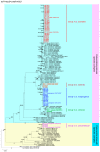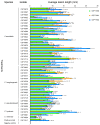Wide Distribution and Intraspecies Diversity in the Pathogenicity of Calonectria in Soil from Eucalyptus Plantations in Southern Guangxi of China
- PMID: 37623573
- PMCID: PMC10455796
- DOI: 10.3390/jof9080802
Wide Distribution and Intraspecies Diversity in the Pathogenicity of Calonectria in Soil from Eucalyptus Plantations in Southern Guangxi of China
Abstract
Eucalyptus spp. are extensively cultivated in southern China because of their adaptability and versatile timber production. Calonectria leaf blight caused by Calonectria species is considered a major threat to Eucalyptus trees planted in China. The GuangXi Zhuang Autonomous Region is the provincial region with the largest distribution of Eucalyptus plantations in China. The present study aimed to expound the species diversity and pathogenicity of Calonectria isolates obtained from the soil of Eucalyptus plantations in GuangXi. A total of 188 Calonectria isolates were recovered from the soil located close to Eucalyptus trees, and the isolates were identified based on the DNA sequence comparisons of the four partial regions of the translation elongation factor 1-alpha (tef1), β-tubulin (tub2), calmodulin (cmdA), and histone H3 (his3) genes. The isolates were identified as Calonectria aconidialis (74.5%), C. hongkongensis (21.3%), C. pseudoreteaudii (2.1%), C. kyotensis (1.6%), and C. chinensis (0.5%). The inoculation results indicated that 40 isolates representing five Calonectria species were pathogenic to the three Eucalyptus genotypes. Two inoculated experiments consistently showed that the longest lesions were produced by the isolates of C. aconidialis. Some isolates of C. aconidialis, C. hongkongensis, and C. kyotensis produced significantly longer lesions than the positive controls, but not the isolates of C. pseudoreteaudii or C. chinensis. These results indicated that Calonectria isolated from the soil may pose a threat to Eucalyptus plantations. Some Calonectria isolates of the same species differed significantly in their virulence in the tested Eucalyptus genotypes. The resistance of different Eucalyptus genotypes to Calonectria isolates within the same species was inconsistent. The inoculation results in this study suggested that many Calonectria isolates in each species had different levels of pathogenicity, and many Eucalyptus genotypes need to be tested to select disease-resistant Eucalyptus genetic materials in the future. The results of the present study enhance our knowledge of species diversity and the potential damage caused by Calonectria in the soil of Eucalyptus plantations. Our results also provide new insights into the breeding of disease-resistant Eucalyptus genotypes for controlling Calonectria leaf blight in China in the future.
Keywords: Calonectria leaf blight; Eucalyptus disease; fungal pathogen; pathogenicity; species diversity.
Conflict of interest statement
The authors declare no conflict of interest.
Figures





Similar articles
-
Diversity and Distribution of Calonectria Species in Soils from Eucalyptus urophylla × E. grandis, Pinus massoniana, and Cunninghamia lanceolata Plantations in Four Provinces in Southern China.J Fungi (Basel). 2023 Feb 3;9(2):198. doi: 10.3390/jof9020198. J Fungi (Basel). 2023. PMID: 36836312 Free PMC article.
-
Evidence of High Genetic Diversity and Differences in the Population Diversity of the Eucalyptus Leaf Blight Pathogen Calonectria pseudoreteaudii from Diseased Leaves and Soil in a Plantation in Guangxi, China.Microorganisms. 2023 Nov 16;11(11):2785. doi: 10.3390/microorganisms11112785. Microorganisms. 2023. PMID: 38004796 Free PMC article.
-
Species Diversity, Mating Strategy and Pathogenicity of Calonectria Species from Diseased Leaves and Soils in the Eucalyptus Plantation in Southern China.J Fungi (Basel). 2021 Jan 20;7(2):73. doi: 10.3390/jof7020073. J Fungi (Basel). 2021. PMID: 33498546 Free PMC article.
-
A rapid and systematic review of the clinical effectiveness and cost-effectiveness of paclitaxel, docetaxel, gemcitabine and vinorelbine in non-small-cell lung cancer.Health Technol Assess. 2001;5(32):1-195. doi: 10.3310/hta5320. Health Technol Assess. 2001. PMID: 12065068
-
Home treatment for mental health problems: a systematic review.Health Technol Assess. 2001;5(15):1-139. doi: 10.3310/hta5150. Health Technol Assess. 2001. PMID: 11532236
Cited by
-
Distribution patterns of Calonectria (Ascomycota, Sordariomycetes, Hypocreales, Nectriaceae) species complexes related to diseased leaves and soil habitats during leaf blight outbreak season in Eucalyptus plantations in southern China.MycoKeys. 2024 Nov 4;110:117-140. doi: 10.3897/mycokeys.110.130733. eCollection 2024. MycoKeys. 2024. PMID: 39533989 Free PMC article.
References
-
- Xie Y.J., Arnold R.J., Wu Z.H., Chen S.F., Du A.P., Luo J.Z. Advances in eucalypt research in China. Front. Agric. Sci. Eng. 2017;4:380–390. doi: 10.15302/J-FASE-2017171. - DOI
-
- Xie Y.J., Du A.P. Eucalyptus in South China. Party School of the CPC Central Committee Press; Beijing, China: 2019. (In Chinese)
-
- Liu T., Xie Y.J. Studies on the Causes of Rapid Development of Eucalyptus Plantations in China. Eucalypt Sci. Technol. 2020;37:38–47. (In Chinese)
Grants and funding
LinkOut - more resources
Full Text Sources
Miscellaneous

